Excerpts from Jim Conrad's
Naturalist Newsletter
from the November 20, 2016 Newsletter issued from Rancho Regenesis in the woods ±4kms west of Ek Balam Ruins; elevation ~40m (~130 ft), N20.876°, W88.170°; north-central Yucatán, MÉXICO
COWPEAS
At the rancho, another vining bean plant has turned up whose name and purpose for being planted have long been forgotten. Below, you can see it growing among the Papayas, where it displays typical garden-bean leaves and an especially pretty flower:
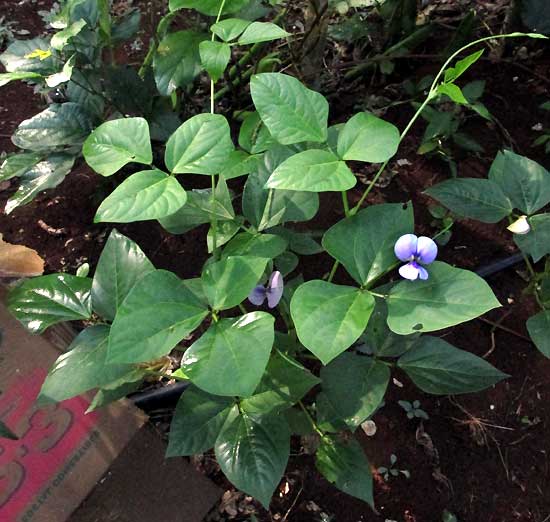
The blossoms, typical of the Bean Family, display five petals arrayed in a particular asymmetric manner known as being "papilionaceous." In papilionaceous flowers the top petal, often known as the "standard," rises above the blossom, attracting pollinators. A shot of one of our vine's flower faces displaying a particularly well developed "standard," one with yellowish spots and dark purple "nectar guides" directing visiting pollinators toward the nectar, appears below:
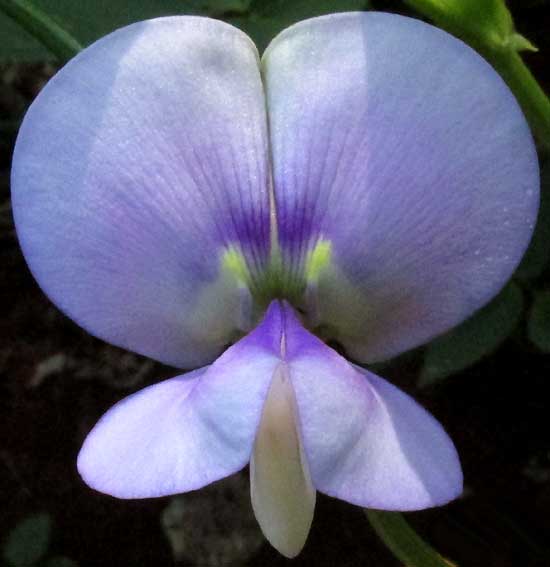
A side-view of the flower showing how the two side petals, the "wings," fold together to form a landing pad for pollinators is shown below:
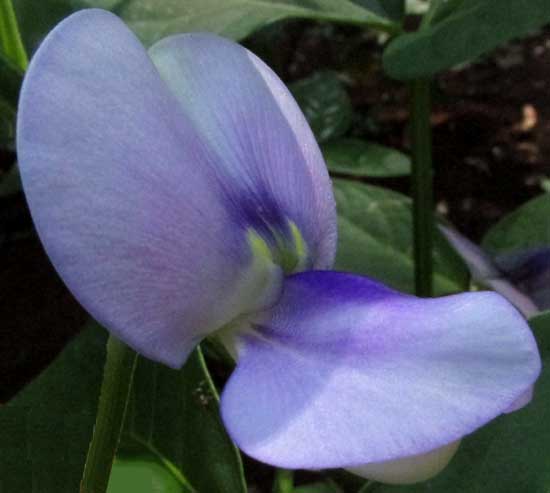
While identifying this vine I needed to know whether the style of the flower's pistil bore hairs or not. It did. Below, you can see the pistil's upward-curving style, quite shaggy along its back side:
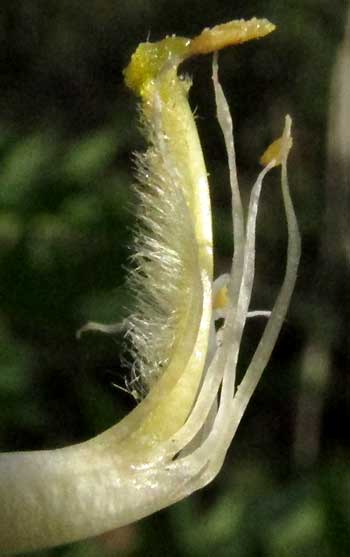
Another diagnostic feature is that its calyx is indented between its sepals for much less than the calyx's entire length, as shown below:
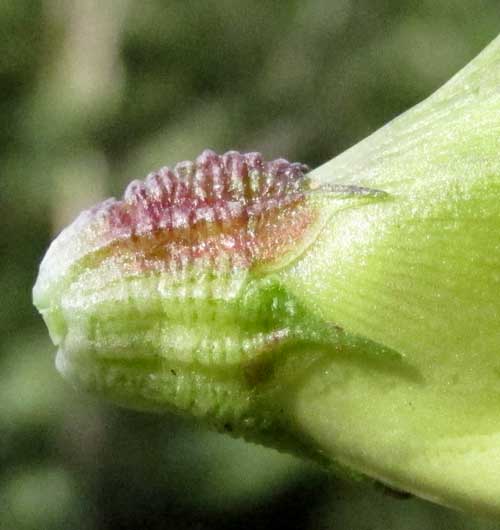
Yet another interesting feature of this bean vine is that its leaves' petioles bear joints with glands that exude some kind of ant-attracting liquid, as shown below:
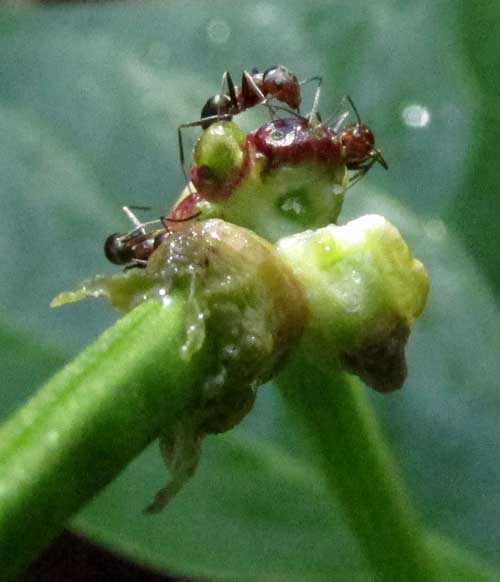
The vine "wants" ants on it in case a vine-eating herbivore comes along. If the critter disturbs the vine, ants will bite it.
Nowadays our plants are just beginning to produce handsome, bean-filled, legume-type fruits, shown below:
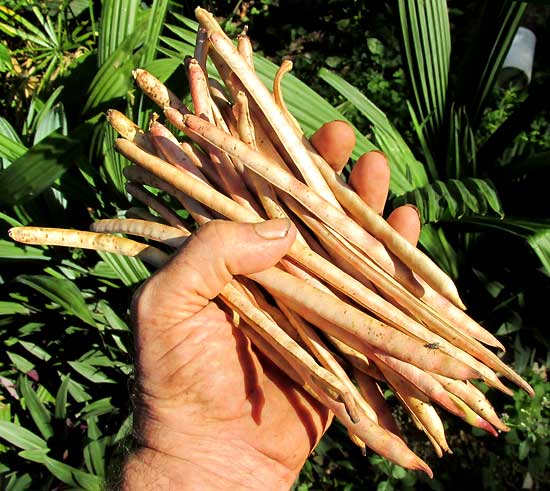
Inside the pods numerous shiny, black beans cradle next to one another, shown below:
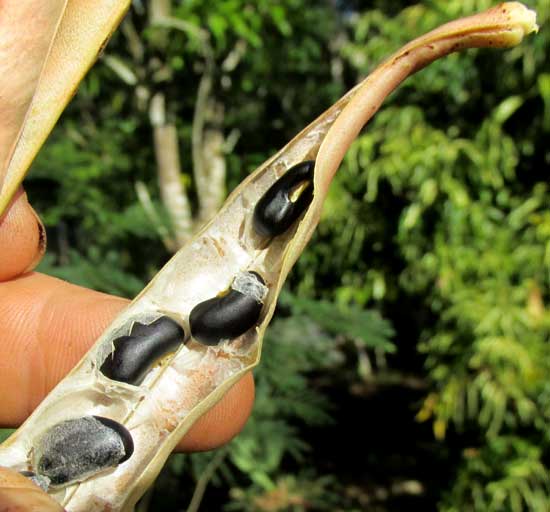
All these features identified our vine as the common Cowpea, VIGNA UNGUICULATA, sometimes also known as Southern Pea or Blackeye Pea, though the Blackeye Peas I've grown up North produced much larger beans, and the beans were of a different color. This isn't a problem with the identification, though, since this species is a very important food crop, and one from which many forms and different cultivars have been developed. When the black beans in the photograph are cooked, their general blackness fades a little, leaving a "black eye" exactly where it should be in a typical Blackeye Pea. The beans I've planted in the north were mainly tan colored, with a black eye, but also they can be clay colored, white, maroon or purplish.
In 2013, in Texas, we ran into this same bean species, but up there we called it the Yardlong Bean, because the vine produced extremely long legumes. {These are described in the next section.}
Yardlong Beans are the same species as what we have here, but they're a different subspecies. They're Vigna unguiculata ssp. sesquipedalis, while the usual subspecies is Vigna unguiculata ssp. unguiculata.
The beans of our local Cowpea race to be too small for eating the way I do regular Blackeye Peas up North, but they're perfect for making bean sprouts. I describe one method for sprouting them at www.backyardnature.net/simple/alf-spr.htm
Cowpea sprouts have a good Blackeye Pea taste.
from the July 21, 2013 Newsletter issued from the Frio Canyon Nature Education Center in the valley of the Dry Frio River in northern Uvalde County, southwestern Texas, on the southern border of the Edwards Plateau, USA
YARDLONG BEAN
My fence-climbing Yardlong Bean vines are producing, as shown below:
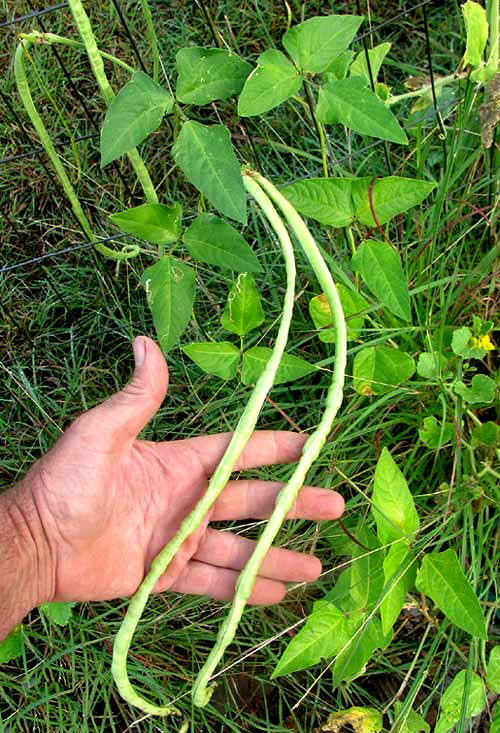
A close-up of a Yardlong Bean's pretty, papilionaceous flower appears below:
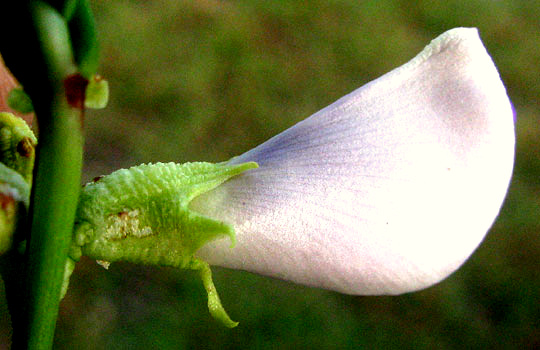
Yardlong Beans are VIGNA UNGUICULATA ssp. SESQUIPEDALIS, and they're known by other common names such as Asparagus Bean, Snake Bean, Chinese Long Bean, Pea Bean and Long-podded Cowpea.
Yardlong Bean's subspecies name, sesquipedalis, is Latin for “a foot and a half long,” which is a more honest description of the Yardlong Bean's pods than the common name, for the legumes average not a yard long but rather about a foot and a half. The Latin "sesquipedalis," by the way, also is the root for the word "sesquipedalian," which means "tending to use long words."
Anyway, noticing that Yardlong Beans are members of the genus Vigna, and not the green bean or snap bean genus Phaseolus, we're alerted to the fact that, despite their outward similarities, Yardlong Beans aren't very closely related to green or snap beans. Last week we looked at green beans so maybe you remember that an important field mark for flowers of species in the genus Phaseolus is that the "keel" part of the blossom is coiled -- the keel being the scoop-shaped structure formed by the flower's two lower petals fusing at their common margin. Our picture of a green bean flower with its side petals, or "wings," pulled back to show the coiled keel remains at www.backyardnature.net/n/13/130714bp.jpg.
You can compare that with a Yardlong Bean flower with its wings pulled back to show the flower's keel below:
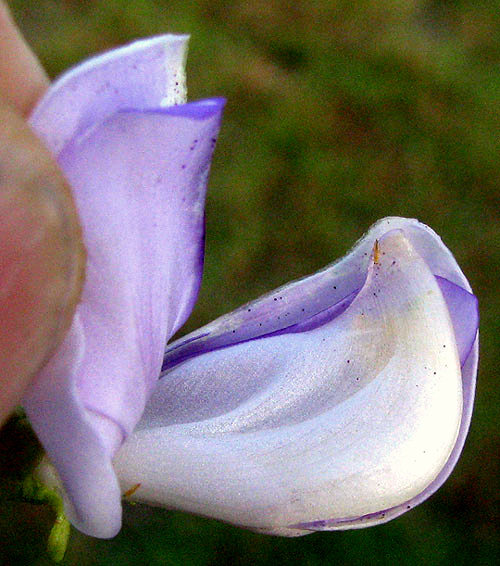
That keel is not at all coiled. The non-coiled keel plus some other more obscure features are significant enough to ban Yardlong Beans from the green bean genus Phaseolus, and assign them to Vigna.
The genus Vigna is worthy to know because it's also the home of mung beans, known by those who sprout beans to eat, and Azuki beans, known to certain discriminating gardeners, as well as black-eyed peas, sometimes called cowpeas. In fact, black-eyed peas are just a different subspecies of the same species that the Yardlong Bean belongs to. Black-eyed Pea plants are Vigna unguiculata ssp. unguiculata.
I first saw Yardlong Beans growing in an isolated Maya village on a mountain slope in southern Guatemala, so I've always figured that they were native to Mexico and Central America. However, genetic sequencing suggests that the wild, ancestral species' home may have been central Africa, perhaps Ghana. The Yardlong Bean subspecies, however, is a cultivar thought to have been developed in eastern Asia. Guatemala's Maya people may have received the cultivar from their Spanish conquerors 500 years ago, time enough for them to have developed their own strains.
Nutritionally, Yardlong Bean pods are regarded as very good sources for vitamin C, folate, magnesium, and manganese. 100 grams of them, providing only 47 calories, gives 23% of the daily requirement of vitamin C needed by an average person. Personally I don't see that Yardlong Beans are any more desirable than regular 'Kentucky Wonder' pole beans, except for the novelty of growing such unusual pods.